If you’re looking for ideas for teaching emergent literacy skills in your classroom, consider the print climate.
Print Climate and Literacy
Welcome to our discussion of chapter 6 of The Read-Aloud Handbook (7th edition) by Jim Trelease. This chapter is titled The Print Climate in the Home, School, and Library. If you’re new to the book study you can find the details HERE.
One of Jim’s rich analogies in chapter 6 is the “print desert” that surrounds the impoverished communities of Watts and Compton in California and the “print rain forest” that surrounds Beverly Hills. Can you guess which group of students performs better on standardized tests and goes on to college? The politicians threw $195 million into phonics instruction to “help” the failing students instead of providing more access to books. I love Jim’s stance on this highly-ineffective strategy “…giving phonics lessons to kids who don’t have any print in their lives is like giving oars to people who don’t have a boat- you don’t get very far.”
Print Climate in the Home
I love how Trelease addresses the elephant in the room, the huge gap in reading scores that exists between the rich and poor. He provides a number of insightful statistics, one of which compares children who have a high interest in books to those who have low interest. It is not surprising to find that those students who have a high interest in books have the largest number of books in the home, the most access to books and are read to daily. He summarizes two decades of research by literacy gurus that proves a direct correlation between access to print with higher reading scores and lack of access with lower scores. Science scores in the twelfth grade can be predicted by the number of books a child has access to in the home. Although the data is there and the answer is crystal clear, we still can’t seem to “fix” this problem.
Print Climate at School
It would make perfect sense if the classroom libraries in Title 1 schools serving predominately at-risk students were well stocked with high-quality literature. Instead, research showed that schools serving the most at-risk populations also had the least access to books and the books were of poor quality. Two of the biggest literacy gurus, Allington and McGill-Franzen conducted a research experiment that provided a group of at-risk students with books during the summer. The end result was very positive and the students showed significant gains. These gains were attributed to access to books, personal ownership of the books, and self-selection of books.
This is why I have always sent books home with every single student daily- access to books. The books are not “mine”; they are ours to share- ownership. The children self-select the books which contributes to motivation to read. Of course, you can lead a horse to water but you can’t make them drink, especially if they have never taken a drink before.
This is why conducting some sort of training for parents at a literacy night or one-on-one parent conferences is so powerful. I also use my Scholastic bonus points to get one book for each child each month.
Print Climate in the Library
I have a confession to make. I am the organizer of this book study and I selfishly selected this chapter because my mother worked in a library for almost 20 years and I also worked in a library for 4 years- I come from a long line of book lovers. What is happening to the libraries in America is a travesty, and it’s not limited to public libraries. Several years ago our school district decided to eliminate school library assistants, split librarians between campuses and shrink the budget for new books. What did that do? It limited access to books and decreased the quality of books- a textbook case of what not to do.
Another excellent point Jim makes is about marketing books to kids and the importance of having them face out. How to provide space for facing books out is one of the things Jim is most well known for- he recommends using rain gutters attached to the walls. I adopted this technique in my classroom many years ago with great success. When you highlight certain books they will appeal to children, here is a picture of my rain gutters in action above. If you think about it, it makes perfect sense. Young children are attracted to the covers of books, not to the tiny print on the spine so facing them out is going to get them to notice those particular books more.
Happy Reading and stay tuned for chapter 7 which will be hosted by Karen over at Prekinders on July 29.
You can catch up on our past chapter discussions at the links below:
- Chapter 1: Scott Wiley of Brick by Brick – July 8
- Chapter 2: Vanessa Levin of Pre-K Pages – July 12
- Chapter 3: Karen Cox of Prekinders – July 15
- Chapter 4: Deborah Stewart of Teach Preschool – July 19
- Chapter 5: Scott Wiley of Brick by Brick – July 22
- Chapter 6: Vanessa Levin of Pre-K Pages -July 26
- Chapter 7: Karen Cox of Prekinders -July 29
- Chapter 8: Laura Eldredge of The Seeds Network -August 2
- Chapter 9: Matt of Look at My Happy Rainbow -August 5
- Chapter 10: Matt of Look at My Happy Rainbow -August 9
Check out the links below for more discussion about The Read-Aloud Handbook by Jim Trelease.
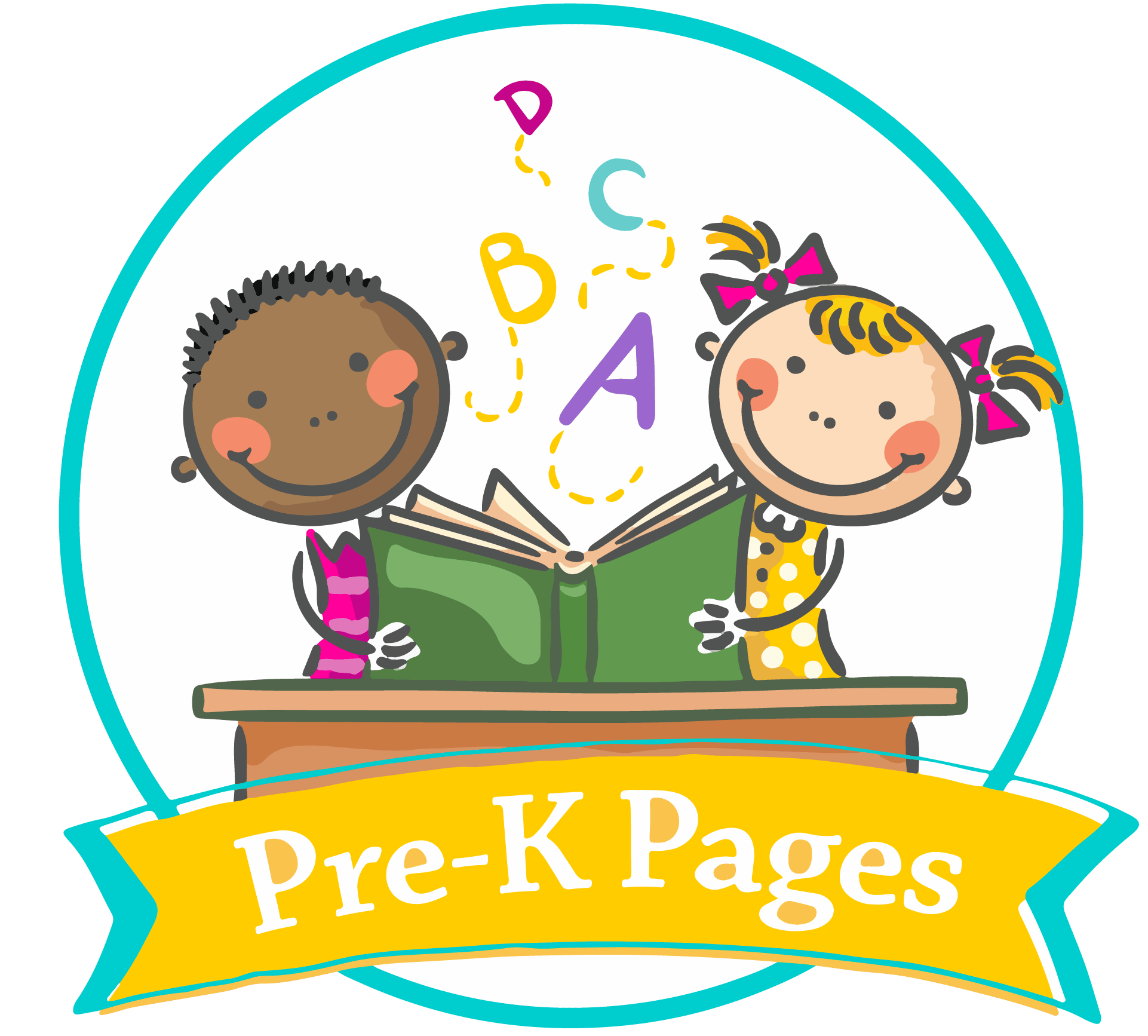
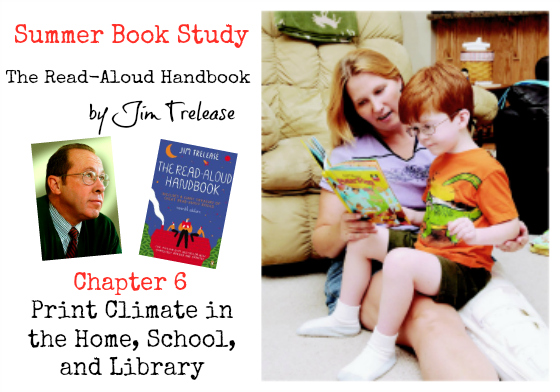

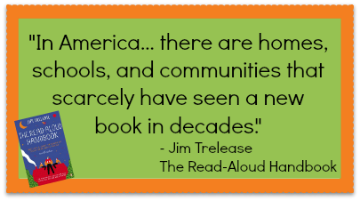

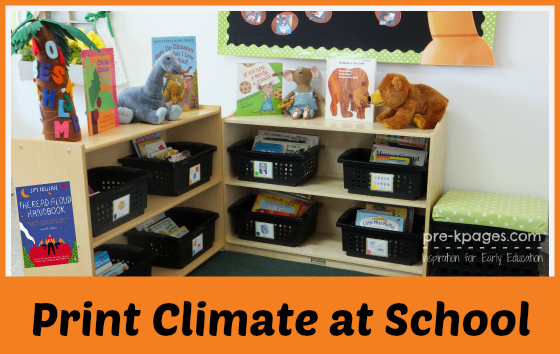
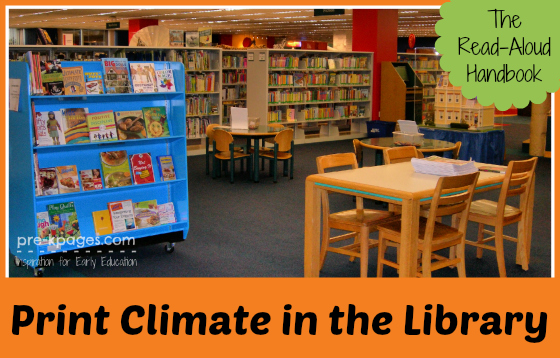


As I continue to read this book, it is becoming evident how the “educators” making decisions for our schools are missing the boat. I love the rain gutter book shelves and look forward to installing some in my classroom.
I have developed about 40 Family Packets that the children get to take home on a take out basis. The Leader of the Day always gets a family packet to take home. Included in the packet is a sheet describing what is in the bag and the number of items. I have an extended activity to go with the book so there is more than the book in the bag. What I find hard is that I lose lots of materials. (and packets along the way) I do have a check out system so I know who has concerns with packets getting back and missing materials. Can suggestions? We talk about how important books are, etc. Many parents have a hard time paying tuition so to say they have to pay for it is just discouraging them to even want to have a packet sent home. I have had parents say “don’t” send those things home. We can’t keep track of them. (There are not more than 3 items per bag).
I love the rain gutter idea for displaying books in the classroom. I am very fortunate to have shelves where I display books in the classroom. I have a few select books that are displayed all year and then I switch others out according to the theme or holiday coming up. I love having an animal that goes with the book because it makes more of a connection to have an object that accompanies the story. I love the Kohls Cares for Kids books and animals and use those as door prizes for various parent workshops and activities.
I am one of those people that love having a book in my hand although I do have an e-reader. I would hate to see libraries go by the wayside. I have fond memories of my childhood spending numerous hours in a library and have tried to do the same with my daughter.
I don’t think libraries will disappear, but the way they operate is changing at a rapid pace. Their services are still very valuable, they just need to adjust those services to meet the needs of the communities they serve. I have seen many libraries that are doing a great job of adapting and making changes such as self checkout, loaning e-books, offering wi-fi etc.
Just like all of the previous chapters, this one was full of interesting facts, ideas, and research. It is such a shame that librarians are being cut when they can be such a valuable resource for the children in our schools. I have never thought about how children are not really taught to use the Internet correctly to conduct research and seldom ever ask a librarian for assistance. When I think of it, every librarian I know wants to be helpful and has a vast amount of knowledge to share about how to conduct research. Teachers really need to think about discussing this with their kids when research projects are coming up. Preschool teachers can jump on that bandwagon by asking librarians to speak in their classrooms and by modeling asking librarians for assistance when researching a particular topic.
I also found Trelease’s advice on series books very interesting and agree that you have to first get children interested in reading. If that’s what does it, it is better to encourage those readings rather than turn a child off to reading altogether. Building off the child’s interest will always bring about more positive results.
Like many others, I love the rain gutter book displays. Can’t wait to see what the next chapter holds in store!
Excellent point Lorrie! I think teaching students the importance of not only visiting the library but utilizing the valuable skills of the librarian is extremely important.